- Home
- Ursula K. Le Guin
No Time to Spare Page 7
No Time to Spare Read online
Page 7
All Archimedes wanted was a solid place to put the lever he was going to move the world with. Same with a story trajectory. You can’t throw a shot put far if you’re standing on a shaky two-inch-wide plank over a deep, dark river. You need a solid footing.
Or do you?
All this author had to stand on is a hokey, sentimental notion, and from it she threw this perfect pitch!
Seldom if ever have I seen the power of pure story over mind, emotion, and artistic integrity so clearly shown.
And I had to think about it, because a few months earlier, I’d read a book that brilliantly demonstrates a narrative gift in the service of clear thought, honest feeling, and passionate integrity. It tells an extremely complicated story extending over many decades and involving many people, from geneticists cloning cells in cloistered laboratories to families in the shack-houses of black farming communities. The story explains scientific concepts and arguments with great clarity while never for a moment losing its onward impetus. It handles the human beings it involves with human compassion and a steady, luminous ethical focus. The prose is of unobtrusive excellence. And if you can stop reading it, you’re a better man than I am, Gunga Din. I couldn’t stop even when I got to the notes—even when I got to the index. More! Go on! Oh please tell me more!
I see a huge difference in literary quality between these two hugely readable books, which certainly has to do with specific qualities of character—among them patience, honesty, risk-taking.
Kathryn Stockett, the white woman who wrote The Help, tells of a white girl persuading black women to tell her intimate details of the injustices and hardships of their lives as servants—a highly implausible undertaking in Mississippi in ’64. When the white employers begin to suspect this tattling, only an equally implausible plot trick lets the black maids keep their jobs. Their sole motivation is knowing their stories will be printed; the mortal risk they would have run in bearing such witness, at that place in that year, is not seriously imagined, but merely exploited to create suspense. White Girl’s motivation is a kind of high-minded ambition. Her risks all become rewards—she loses malevolent friends and a bigoted boyfriend and leaves Mississippi behind for a brilliant big-city career. The author’s sympathy for the black women and knowledge of their everyday existence is evident, but, for me, it was made questionable by her assumption of a right to speak for people without earning that right, and killed dead by the wish-fulfilling improbability of her story.
Rebecca Skloot, the white woman who wrote The Immortal Life of Henrietta Lacks, spent years researching a vastly complex web of scientific research, thefts, discoveries, mistakes, deceits, cover-ups, exploitations, and reparations, while at the same time trying, with incredible patience and good will, to gain the trust of the people most directly affected by the one human life with which all that research and profit-making began—the family of Henrietta Lacks. These were people who had good reason to feel that they would be endangered or betrayed if they trusted any white person. It took her literally years to win their confidence. Evidently she showed them that she deserved it by her patient willingness to listen and learn, her rigorous honesty, and her compassionate awareness of who and what was and is truly at risk.
“Of course her story is superior,” says Mr. Gradgrind. “It’s nonfiction—it’s true. Fiction is mere hokum.”
But oh, Mr. Gradgrind, so much nonfiction is awful hokum! How bad and mean my mommy was to me before I found happiness in buying a wonderful old castle in Nodonde and fixing it up as an exclusive gourmet B&B while bringing modern educational opportunities to the village children . . .
And contrarily, we can learn so much truth by reading novels, such as the novel in which you appear, Mr. Gradgrind.
No, that’s not where the problem lies. The problem—my problem—is with the gift of story.
If one of the two books I’ve been talking about is slightly soiled fluff while the other is solid gold, how come I couldn’t stop reading either of them?
It Doesn’t Have to Be the Way It Is
June 2011
The test of fairyland [is that] you cannot imagine two and one not making three but you can easily imagine trees not growing fruit; you can imagine them growing golden candlesticks or tigers hanging on by the tail.
THE QUOTATION, FROM G. K. Chesterton, is from an interesting article by Bernard Manzo in the Times Literary Supplement of June 10, 2011 (he didn’t give the source in Chesterton’s writings). It got me to thinking about how imaginative literature, from folktale to fantasy, operates, and to wondering about its relationship to science, though I’ll only get to that at the very end of this piece.
The fantastic tale may suspend the laws of physics—carpets fly; cats fade into invisibility, leaving only a smile—and of probability—the youngest of three brothers always wins the bride; the infant in the box cast upon the waters survives unharmed—but it carries its revolt against reality no further. Mathematical order is unquestioned. Two and one make three, in Koschei’s castle and Alice’s Wonderland (especially in Wonderland). Euclid’s geometry—or possibly Riemann’s—somebody’s geometry, anyhow—governs the layout. Otherwise incoherence would invade and paralyze the narrative.
There lies the main difference between childish imaginings and imaginative literature. The child “telling a story” roams about among the imaginary and the half-understood without knowing the difference, content with the sound of language and the pure play of fantasy with no particular end, and that’s the charm of it. But fantasies, whether folktales or sophisticated literature, are stories in the adult, demanding sense. They can ignore certain laws of physics but not of causality. They start here and go there (or back here), and though the mode of travel may be unusual, and here and there may be wildly exotic and unfamiliar places, yet they must have both a location on the map of that world and a relationship to the map of our world. If not, the hearer or reader of the tale will be set adrift in a sea of inconsequential inconsistencies, or, worse yet, left drowning in the shallow puddle of the author’s wishful thinking.
It doesn’t have to be the way it is. That is what fantasy says. It doesn’t say, “Anything goes”—that’s irresponsibility, when two and one make five, or forty-seven, or whuddevva, and the story doesn’t “add up,” as we say. Fantasy doesn’t say, “Nothing is”—that’s nihilism. And it doesn’t say, “It ought to be this way”—that’s utopianism, a different enterprise. Fantasy isn’t meliorative. The happy ending, however enjoyable to the reader, applies to the characters only; this is fiction, not prediction and not prescription.
It doesn’t have to be the way it is is a playful statement, made in the context of fiction, with no claim to “being real.” Yet it is a subversive statement.
Subversion doesn’t suit people who, feeling their adjustment to life has been successful, want things to go on just as they are, or people who need support from authority assuring them that things are as they have to be. Fantasy not only asks “What if things didn’t go on just as they do?” but demonstrates what they might be like if they went otherwise—thus gnawing at the very foundation of the belief that things have to be the way they are.
So here imagination and fundamentalism come into conflict.
A fully created imaginary world is a mental construct similar in many respects to a religious or other cosmology. This similarity, if noticed, can be deeply disturbing to the orthodox mind.
When a fundamental belief is threatened the response is likely to be angry or dismissive—either “Abomination!” or “Nonsense!” Fantasy gets the abomination treatment from religious fundamentalists, whose rigid reality-constructs shudder at contact with questioning, and the nonsense treatment from pragmatic fundamentalists, who want to restrict reality to the immediately perceptible and the immediately profitable. All fundamentalisms set strict limits to the uses of imagination, outside which the fundamentalist’s imagination itself runs riot, fancying dreadful deserts where God and Reason and the capitalist way
of life are lost, forests of the night where tigers hang from trees by the tail, lighting the way to madness with their bright burning.
Those who dismiss fantasy less fiercely, from a less absolutist stance, usually call it dreaming, or escapism.
Dream and fantastic literature are related only on a very deep, usually inaccessible level of the mind. Dream is free of intellectual control; its narratives are irrational and unstable, and its aesthetic value is mostly accidental. Fantastic literature, like all the verbal arts, must satisfy the intellectual as well as the aesthetic faculty. Fantasy, odd as it sounds to say so, is a perfectly rational undertaking.
As for the charge of escapism, what does escape mean? Escape from real life, responsibility, order, duty, piety, is what the charge implies. But nobody, except the most criminally irresponsible or pitifully incompetent, escapes to jail. The direction of escape is toward freedom. So what is “escapism” an accusation of?
“Why are things as they are? Must they be as they are? What might they be like if they were otherwise?” To ask these questions is to admit the contingency of reality, or at least to allow that our perception of reality may be incomplete, our interpretation of it arbitrary or mistaken.
I know that to philosophers what I’m saying is childishly naive, but my mind cannot or will not follow philosophical argument, so I must remain naive. To an ordinary mind not trained in philosophy, the question—do things have to be the way they are/the way they are here and now/the way I’ve been told they are?—may be an important one. To open a door that has been kept closed is an important act.
Upholders and defenders of a status quo, political, social, economic, religious, or literary, may denigrate or diabolize or dismiss imaginative literature, because it is—more than any other kind of writing—subversive by nature. It has proved, over many centuries, a useful instrument of resistance to oppression.
Yet as Chesterton pointed out, fantasy stops short of nihilist violence, of destroying all the laws and burning all the boats. (Like Tolkien, Chesterton was an imaginative writer and a practicing Catholic, and thus perhaps particularly aware of tensions and boundaries.) Two and one make three. Two of the brothers fail the quest, the third carries it through. Action is met with reaction. Fate, Luck, Necessity are as inexorable in Middle-earth as in Colonus or South Dakota. The fantasy tale begins here and ends there (or back here), where the subtle and ineluctable obligations and responsibilities of narrative art have taken it. Down on the bedrock, things are as they have to be. It’s only everywhere above the bedrock that nothing has to be the way it is.
There really is nothing to fear in fantasy unless you are afraid of the freedom of uncertainty. This is why it’s hard for me to imagine that anyone who likes science can dislike fantasy. Both are based so profoundly on the admission of uncertainty, the welcoming acceptance of unanswered questions. Of course the scientist seeks to ask how things are the way they are, not to imagine how they might be otherwise. But are the two operations opposed, or related? We can’t question reality directly, only by questioning our conventions, our belief, our orthodoxy, our construction of reality. All Galileo said, all Darwin said, was, “It doesn’t have to be the way we thought it was.”
Utopiyin, Utopiyang
April 2015
THESE ARE SOME thoughts about utopia and dystopia.
The old, crude Good Places were compensatory visions of controlling what you couldn’t control and having what you didn’t have here and now—an orderly, peaceful heaven; a paradise of hours; pie in the sky. The way to them was clear, but drastic. You died.
Thomas More’s secular and intellectual construct Utopia was still an expression of desire for something lacking here and now—rational human control of human life—but his Good Place was explicitly No Place. Only in the head. A blueprint without a building site.
Ever since, utopia has been located not in the afterlife but just off the map, across the ocean, over the mountains, in the future, on another planet, a livable yet unattainable elsewhere.
Every utopia since Utopia has also been, clearly or obscurely, actually or possibly, in the author’s or in the readers’ judgment, both a good place and a bad one. Every eutopia contains a dystopia, every dystopia contains a eutopia.
In the yang-yin symbol each half contains within it a portion of the other, signifying their complete interdependence and continual intermutability. The figure is static, but each half contains the seed of transformation. The symbol represents not a stasis but a process.
It may be useful to think of utopia in terms of this long-lived Chinese symbol, particularly if one is willing to forgo the usual masculinist assumption that yang is superior to yin, and instead consider the interdependence and intermutability of the two as the essential feature of the symbol.
Yang is male, bright, dry, hard, active, penetrating. Yin is female, dark, wet, easy, receptive, containing. Yang is control, yin acceptance. They are great and equal powers; neither can exist alone, and each is always in process of becoming the other.
Both utopia and dystopia are often an enclave of maximum control surrounded by a wilderness—as in Butler’s Erewhon, E. M. Forster’s “The Machine Stops,” and Yevgeny Zamyatin’s We. Good citizens of utopia consider the wilderness dangerous, hostile, unlivable; to an adventurous or rebellious dystopian it represents change and freedom. In this I see examples of the intermutability of the yang and yin: the dark mysterious wilderness surrounding a bright, safe place, the Bad Places—which then become the Good Place, the bright, open future surrounding a dark, closed prison . . . Or vice versa.
In the last half century this pattern has been repeated perhaps to exhaustion, variations on the theme becoming more and more predictable, or merely arbitrary.
Notable exceptions to the pattern are Huxley’s Brave New World, a eudystopia in which the wilderness has been reduced to an enclave so completely dominated by the intensely controlled yang world-state that any hope of its offering freedom or change is illusory; and Orwell’s 1984, a pure dystopia in which the yin element has been totally eliminated by the yang, appearing only in the receptive obedience of the controlled masses and as manipulated delusions of wilderness and freedom.
Yang, the dominator, always seeks to deny its dependence on yin. Huxley and Orwell uncompromisingly present the outcome of successful denial. Through psychological and political control, these dystopias have achieved a nondynamic stasis that allows no change. The balance is immovable: one side up, the other down. Everything is yang forever.
Where is the yin dystopia? Is it perhaps in post-holocaust stories and horror fiction with its shambling herds of zombies, the increasingly popular visions of social breakdown, total loss of control—chaos and old night?
Yang perceives yin only as negative, inferior, bad, and yang has always been given the last word. But there is no last word.
At present we seem only to write dystopias. Perhaps in order to be able to write a utopia we need to think yinly. I tried to write one in Always Coming Home. Did I succeed?
Is a yin utopia a contradiction in terms, since all the familiar utopias rely on control to make them work, and yin does not control? Yet it is a great power. How does it work?
I can only guess. My guess is that the kind of thinking we are, at last, beginning to do about how to change the goals of human domination and unlimited growth to those of human adaptability and long-term survival is a shift from yang to yin, and so involves acceptance of impermanence and imperfection, a patience with uncertainty and the makeshift, a friendship with water, darkness, and the earth.
The Annals of Pard
The Trouble
January 2013
I’VE NEVER HAD a cat before who directly challenged me. I don’t look for much obedience from a cat; the relationship isn’t based on rank or a dominance hierarchy as with dogs, and cats have no guilt and very little shame. I expect a cat to steal food left out on the counter knowing perfectly well that he’ll be swatted if caught. Greed, and
possibly the joy of theft, overrides the slight fear. Stupid human me to leave food out on the counter. I expect a cat who has been scolded or swatted for getting up on the dining table to get up on the dining table and leave little footprints all over it, because he sees no reason to refrain from doing so when I’m not in the room. When found later, the evidence of the little footprints will have passed the statute of limitations. To make any sense to a cat, retaliation for wrongdoing must be immediate. The cat knows that as well as I do, which is why I expect him to do wrong while I’m not in the room, and don’t expect him to do wrong while I am.
To do wrong under my very eyes strains our relationship. It demands scolding, swatting, shouting, flight, pursuit, commotion. It is a challenge, a deliberate invitation to trouble. And this is where Pard is different from the many and various cats who have companioned me. They were all like me—they wanted to avoid trouble.
Pard wants to make it.
He isn’t a troublesome cat. His hygiene is impeccable. He is gentle. He never steals food. (To be sure, this is only because he doesn’t recognize anything but kibbled catfood as food. I can leave the pork cutlets on the counter while he’s waiting hungrily for his quarter cup of dinner kibbles, and he won’t even get up to sniff them. I could put a piece of bacon on top of his kibbles and he would eat them and leave it. I could lay a filet of sole down on him and he would shake it off with contempt and go away.)

 Catwings
Catwings Tehanu
Tehanu The Tombs of Atuan
The Tombs of Atuan A Wizard of Earthsea
A Wizard of Earthsea The Other Wind
The Other Wind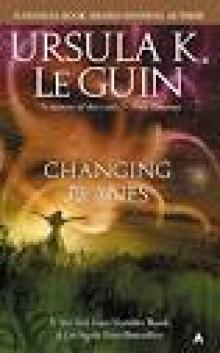 Ursula K. Le Guin
Ursula K. Le Guin Dangerous People
Dangerous People Worlds of Exile and Illusion: Rocannon's World, Planet of Exile, City of Illusions
Worlds of Exile and Illusion: Rocannon's World, Planet of Exile, City of Illusions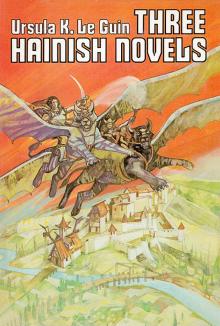 Three Hainish Novels
Three Hainish Novels The Left Hand Of Darkness (SF Masterworks)
The Left Hand Of Darkness (SF Masterworks) The Unreal and the Real - Vol 1 - Where On Earth
The Unreal and the Real - Vol 1 - Where On Earth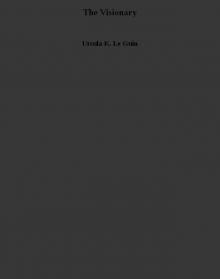 The Visionary
The Visionary The Ones Who Walk Away from Omelas
The Ones Who Walk Away from Omelas The Word for World is Forest
The Word for World is Forest Always Coming Home
Always Coming Home The Unreal and the Real - Vol 2 - Outer Space, Inner Lands
The Unreal and the Real - Vol 2 - Outer Space, Inner Lands Malafrena
Malafrena The Lathe of Heaven
The Lathe of Heaven Five Ways to Forgiveness
Five Ways to Forgiveness The Eye of the Heron
The Eye of the Heron Four Ways to Forgiveness
Four Ways to Forgiveness Powers
Powers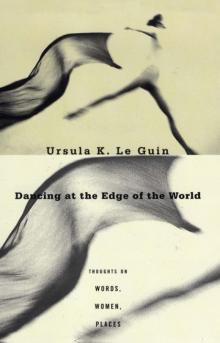 Dancing at the Edge of the World
Dancing at the Edge of the World Very Far Away from Anywhere Else
Very Far Away from Anywhere Else Voices aotws-2
Voices aotws-2 The New Atlantis
The New Atlantis The Unreal and the Real, Selected Stories of Ursula K. Le Guin Volume 1: Where on Earth
The Unreal and the Real, Selected Stories of Ursula K. Le Guin Volume 1: Where on Earth The Telling
The Telling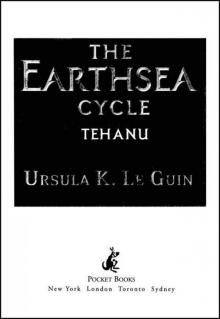 Tehanu (Earthsea Cycle)
Tehanu (Earthsea Cycle) Nine Lives twtq-9
Nine Lives twtq-9 The Birthday of the World and Other Stories
The Birthday of the World and Other Stories The Dispossessed
The Dispossessed Changing Planes
Changing Planes Words Are My Matter
Words Are My Matter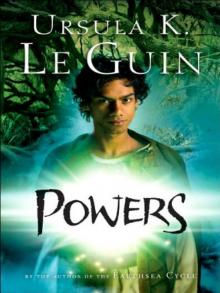 Powers aotws-3
Powers aotws-3 Lavinia
Lavinia The Wind's Twelve Quarters
The Wind's Twelve Quarters Orsinian Tales
Orsinian Tales Gifts aotws-1
Gifts aotws-1 Coming of Age in Karhide
Coming of Age in Karhide The Books of Earthsea: The Complete Illustrated Edition
The Books of Earthsea: The Complete Illustrated Edition The Found and the Lost
The Found and the Lost No Time to Spare
No Time to Spare Voices
Voices The Wild Girls
The Wild Girls Old Music and the Slave Women
Old Music and the Slave Women The Daughter of Odren
The Daughter of Odren A Fisherman of the Inland Sea: Stories
A Fisherman of the Inland Sea: Stories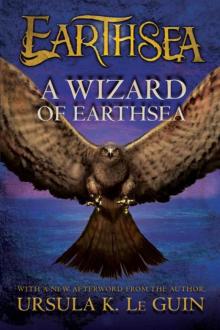 A Wizard of Earthsea (The Earthsea Cycle)
A Wizard of Earthsea (The Earthsea Cycle)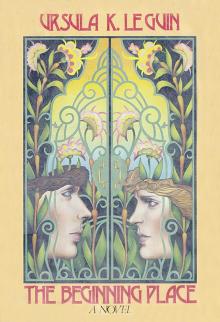 The Beginning Place
The Beginning Place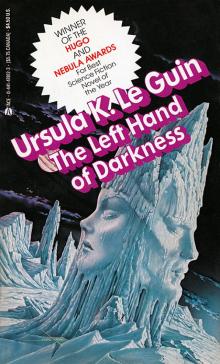 The Left Hand of Darkness
The Left Hand of Darkness The Farthest Shore (Earthsea Cycle)
The Farthest Shore (Earthsea Cycle) The Matter of Seggri botw-2
The Matter of Seggri botw-2